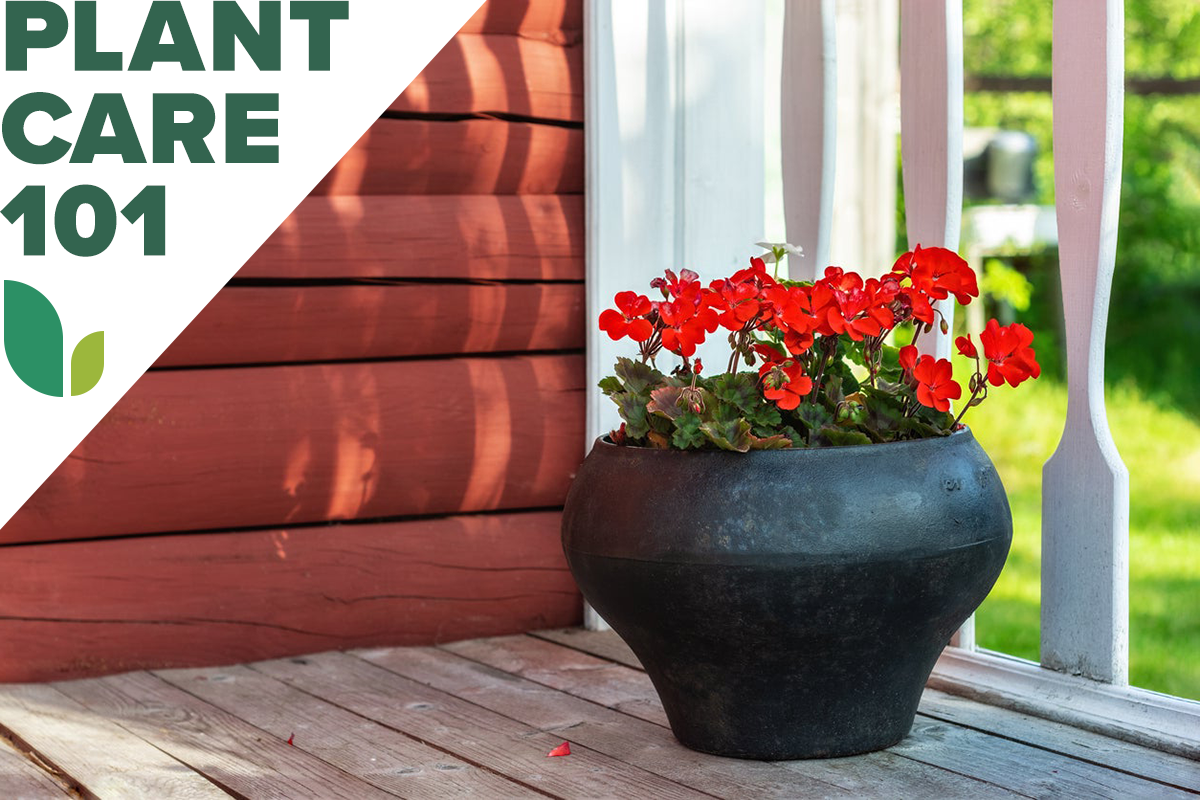

We may earn revenue from the products available on this page and participate in affiliate programs. Learn More ›
If the sight of a bright red geranium in a pot on the porch gives you a nostalgic feeling, you’re not alone. This hardy annual flowering plant native to South Africa has been cultivated in gardens around the world since the late 1700s, so there’s a high chance you have a relative or two who has grown them.
Why has this plant remained so popular for so long? Geranium care is relatively fuss-free. That means geraniums don’t require a lot of water, food, or garden skills to look great. There are many geranium varieties, so it is easy to find one to suit any garden, whether featured in a window box or lining the border of a large bed. Here are some tried-and-true geranium care tips that will help you grow this beautiful flower.
RELATED: 10 Low-Maintenance Houseplants to Keep Indoor Air Fresh
Growing Geraniums at a Glance
Common Name: Geranium, garden geranium
Scientific Name: Pelargonium
Hardiness Zone: 10 to 12, annual in colder zones
Soil: Fertile, well-draining soil; pH 6 to 7.5
Light: Full sun, partial shade in hot climates
Water: Moderate to regular water
Food: Little to no feeding in rich soil; 3 or 4 feedings during active growing season in poor soil
Propagation: Sow seed indoors or propagate from stem cuttings.
Safety: Mild toxicity to pets in some varieties
Geranium Characteristics
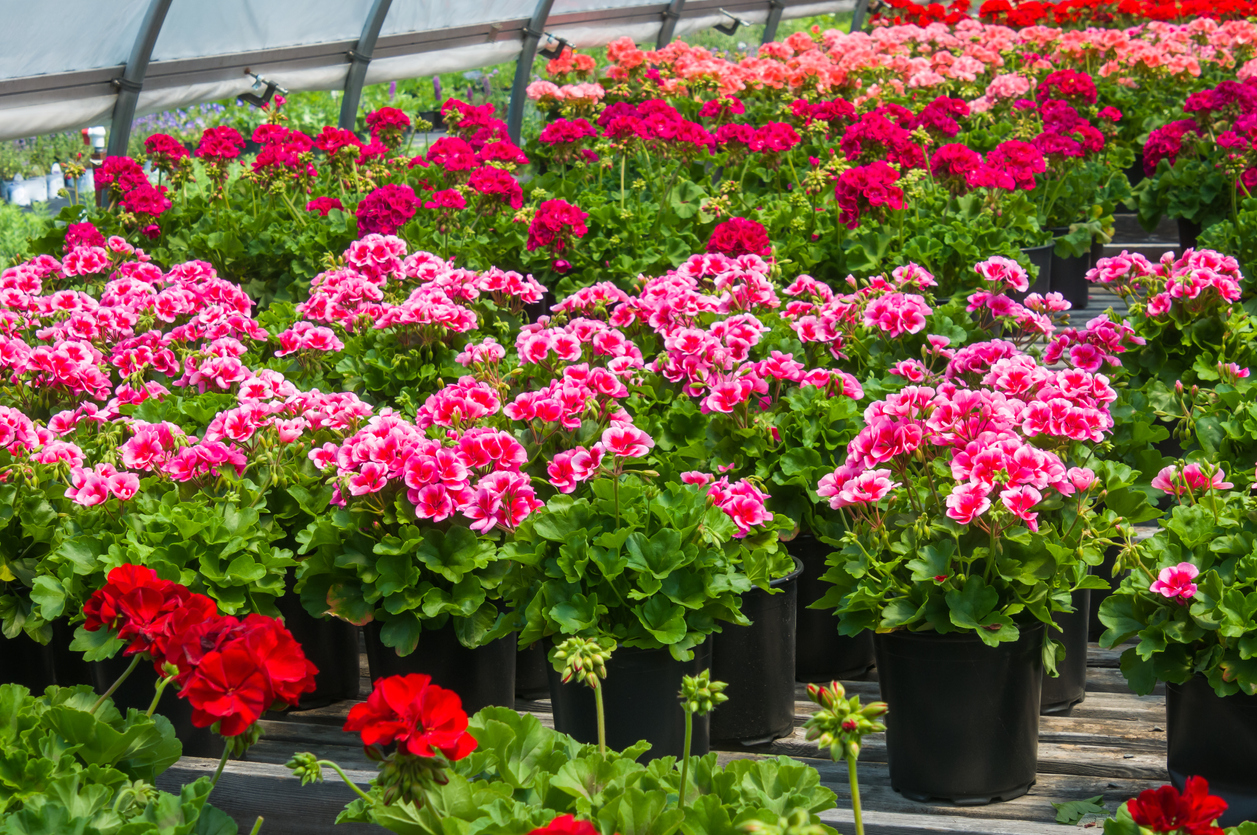
Garden geraniums are popular for a reason; geranium flowers boast spectacular colors and most varieties produce showy, long-lasting blooms. The plants themselves, however, are low-maintenance. Common geraniums, aka Pelargonium, can grow up to 2 feet tall and wide. Their leaves range from soft velvet black to chartreuse, and their flowers can be white, red, pink, orange, and deep purple.
Generally speaking, most gardeners mean Pelargonium when talking about geraniums, but it’s not technically correct. True geranium, aka cranesbill, is a perennial geranium that usually grows low to the ground. However, referring to pelargoniums as geraniums has been in common practice since the late 18th century, so no one will fault you for calling them by their popular name.
There are several types of geraniums of note. Garden geraniums, or common geraniums (Pelargonium x hortorum), are the classic flowers your grandparents grew in their flower beds or containers. P. zonale are zonal geraniums, a P. x hortorum variety that can survive slightly cooler temperatures. There are also scented geraniums (P. spp.), which are prized for their scented leaves with aromas resembling lime, lemon, rose, and even nutmeg.
Ivy geranium, P. peltatum, has ivy-shaped leaves that trail over pots and beds, and its flowers tend to be less showy than those of P. x hortorum. Lady Washington or Martha Washington pelargonium have less-rounded geranium leaves than their cousins, but their flowers are frequently bicolored.
Recommended Geranium Varieties
- Skies of Italy (P. x hortorum variegated ‘Skies of Italy’): Variegated white and green leaves with bright red flowers.
- Indian Dunes (P. x hortorum ‘Indian Dunes’): A chartreuse leaf with a bronze center with red-orange flowers.
- Daredevil Claret (P. zonale ‘Daredevil Claret’): A big bloomer with bright red flowers, these red geraniums are slightly more cold-tolerant than other types.
- Daredevil Snow (P. zonale ‘Daredevil Snow’): Another hardy geranium with an abundance of beautiful snow-white flowers, daredevil snow looks stunning in a monochromatic garden or moon garden.
- Black Velvet Rose (P. x hortorum ‘Black Velvet Rose’): A dark-leafed geranium with a striking contrast of soft-pink flowers.
- Mosquito Shoo Scented Geranium (P. crispum): A lemony citronella–scented geranium said to repel mosquitoes in the immediate area.
- Nutmeg-Scented Geranium (P. x fragrans ‘Nutmeg’): A nutmeg-scented geranium with small white flowers.
RELATED: 14 Fragrant Indoor Plants That’ll Make Your Home Smell Amazing
Planting Geraniums
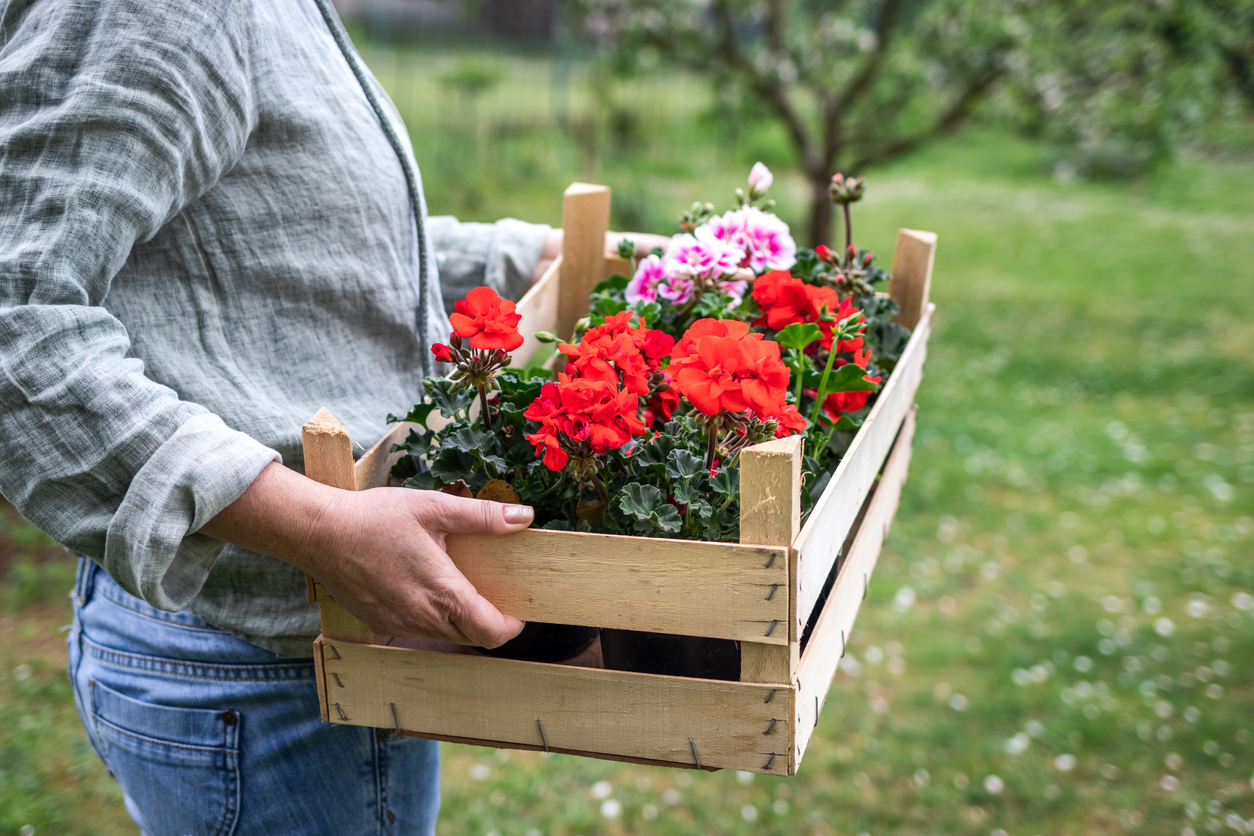
Common geraniums can be grown as perennials in USDA Zones 10 to 12, and some varieties are also hardy in Zone 9. In colder regions, they are grown as hardy annuals, usually in containers that are brought inside for wintering geraniums. True geranium species often are more cold hardy, but it varies by hardiness zone.
Grow geraniums in full sun. In hot climates, partial sun is fine. A common bedding plant, they should be grown in fertile, fast-draining soil. If the soil is rich, geraniums only need a little fertilizer during the growing season; they’ll need more in sandy or nutrient-deprived soil. However, all geraniums love containers.
When is the best time to plant geraniums?
Plant geraniums directly in your garden after all danger of frost has passed. This can be anywhere from February in mild climates to May in northern climates. In Zones 10 through 12 (and Zone 9 for some types), geraniums can be kept outside year-round, but you should plant new geraniums only in warmer months.
Where can geraniums grow?
Geraniums can grow in full sun. In climates with very hot summers, partial sun is fine. Geraniums prefer to be a little bit root-bound, making them suitable for containers, window boxes, and narrow garden beds as well as raised beds and borders. Plant bright red geraniums in front of blue hydrangea flowers for an easy, show-stopping flower bed.
How do you plant geraniums?
Before you plant your geranium, give it a thorough watering a couple of hours before removing it from its nursery pot. Then allow the soil to dry a little.
If planting in the ground:
- Dig a hole a few inches deeper and a little wider than the geranium’s pot.
- Remove the plant from its grower’s pot (typically a 4- or 6-inch plastic pot).
- Fill in the hole with some rich planting mix, and place the geranium so that its crown is level with the soil.
- Add planting mix to the sides and surface of the plant.
- Water thoroughly, but do not flood.
If planting in a container:
- Select a container that allows for a few inches of growth both in width and depth.
- Fill the pot with potting soil, leaving room for the geranium.
- Remove the plant from its grower’s pot (typically a 4- or 6-inch plastic pot).
- Add the geranium to the container, making sure to fill in enough dirt underneath to make the geranium’s crown level with the container’s soil (typically allow 2 to 3 inches of space from the lip of the pot).
- Water, but do not flood.
Do geraniums grow well in containers?
Geraniums thrive in containers, so geranium care is just as easy when they are in pots. Plus, planting geraniums in pots offers the option of bringing geraniums indoors to overwinter. In general, geraniums don’t mind being a little root-bound, so they don’t require a ton of growing space to still look their best. The best pots for geraniums are only about a size larger than the nursery pots they come in. With so many geranium colors, container-grown plants can complement indoor, patio, or deck decor and outdoor landscapes.
RELATED: 14 Symptoms of an Unhappy Houseplant (and How You Can Treat Them)
Watering Geraniums

One of the most common mistakes gardeners make with geraniums is overwatering. Geraniums can handle dry conditions better than many other annuals, and they absolutely can’t tolerate being soggy.
In the ground, water a geranium only if it’s been persistently dry and hot. In containers, allow the soil to dry out completely between waterings. For this reason, it is also a good idea to plant geraniums with other sun-loving container plants and drought-tolerant plants, such as perennial grasses, coneflowers, and succulents.
Fertilizing Geraniums
Geraniums are big bloomers but not heavy feeders. If planted in well-draining, richly composted garden soil at the beginning of the season, they may not need any fertilizing at all. If planted in containers or poor soil, fertilize geraniums once a month during the peak growing season (May through September). The best fertilizer for geraniums is a balanced mix, like 10-10-10 or 15-15-15.
Pruning Geraniums
Geraniums are some of the lowest-maintenance plants in the garden, since their flowers are long lasting. However, to encourage new flowering, remove blooms as soon as they fade or if they look damaged after a heavy rainstorm. The plants do not need heavy pruning, and you can remove dead or yellowed leaves by hand.
Leggier geranium varieties, such as Martha Washington, may require some pruning to keep a rounder, neater shape. Geraniums kept indoors will become bushier if the stalks are cut back to about 4 to 6 inches long in early spring before taking them outdoors again.
Propagating Geraniums
Geraniums can be propagated both from seed and cuttings, but most growers purchase them in 4-inch or larger growing pots ready to pop into a container or the garden.
Learning how to propagate geraniums requires a bit of a learning curve because they require a consistent temperature to germinate. Geraniums can be propagated from seed by sowing seeds indoors in winter (January or February) and keeping the seeds at a constant temperature of 70 to 75 degrees Fahrenheit. They can then be planted outside after your last frost date has passed.
Some gardeners have success propagating geraniums from cuttings toward the end of the warmest months (July and August) and keeping them inside until the following spring.
RELATED: 10 Houseplants You Can Propagate the Fastest for an Ever-Expanding Indoor Garden
Safety Considerations
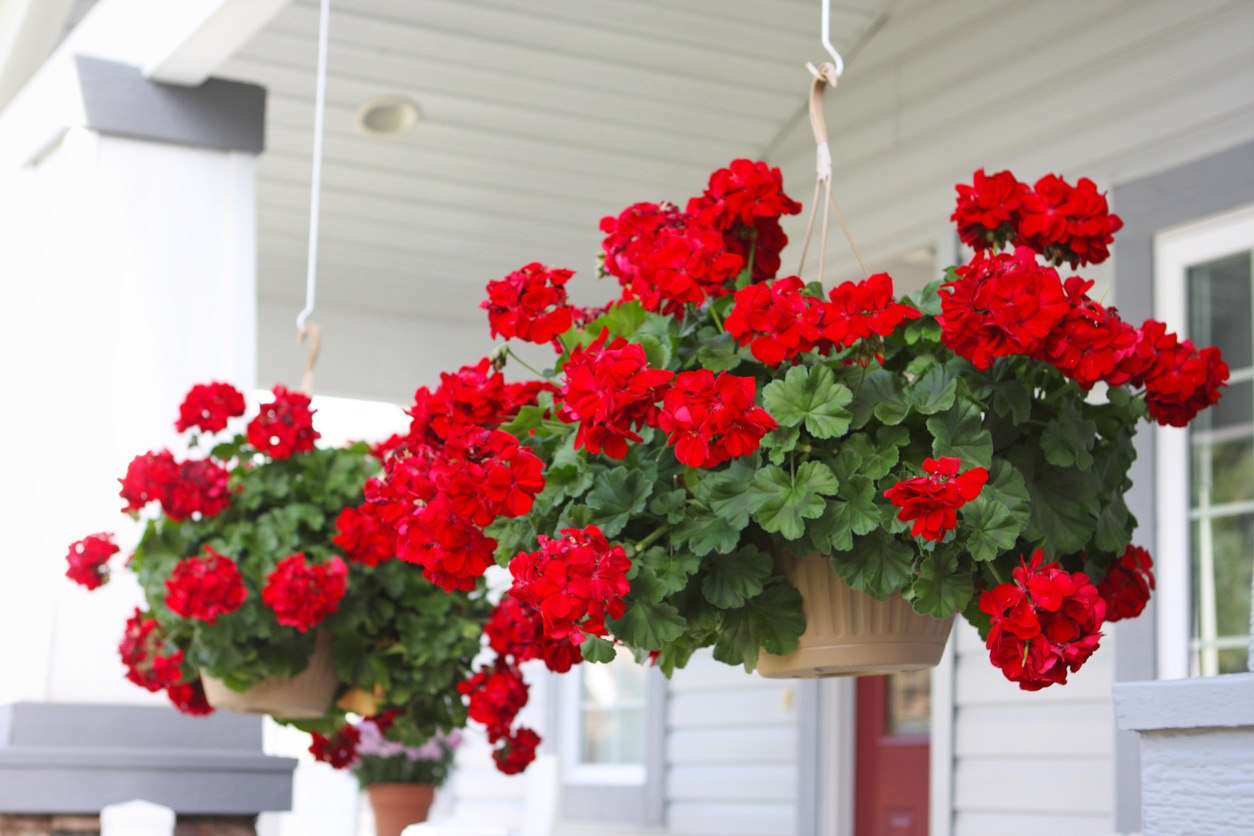
Geraniums contain the chemicals geraniol and linalool in their leaves and flowers. These chemicals are toxic to dogs, cats, and horses if consumed. Scented geraniums have more of these compounds in their leaves, making them mildly more toxic than common varieties.
Potential Pests and Diseases
Geraniums generally tend to be resilient plants. The most common geranium pests include aphids, spider mites, and whiteflies, all of which can be treated with a mild insecticidal soap. Often these pests are attracted to stressed, overwatered plants. If your flowers look tattered, this could be a sign of geranium budworms, also known as tobacco budworms. Bacillus thuringiensis (Bt) can sometimes be effective against the budworm without harming other pollinators.
Preparing Geraniums for Winter
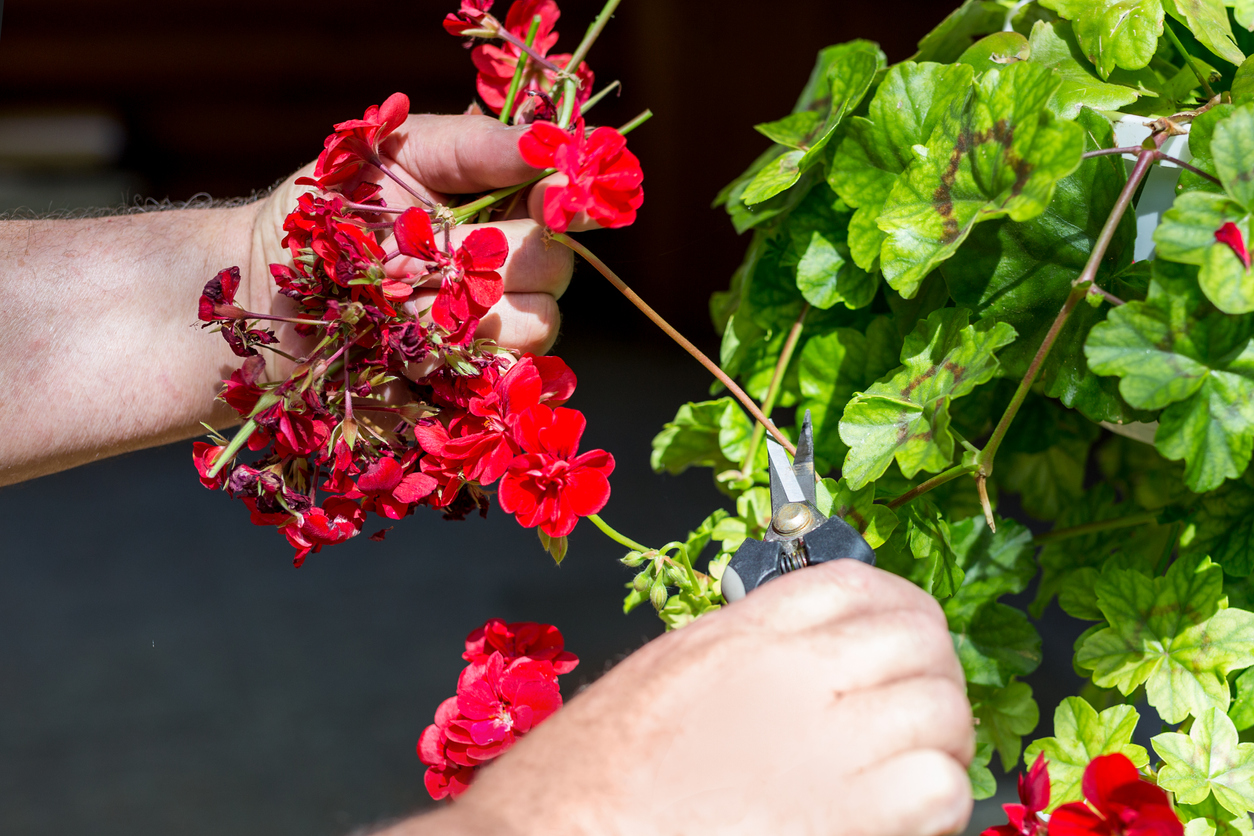
If you live in USDA Zones 9 to 12, your primary wintering duties for most of your geraniums will be deadheading flowers and handpicking any brown or yellow leaves. If your geraniums are leggy due to lack of sunlight, you can trim them back, but you should not need to do any heavy pruning.
In areas where there is frost, geraniums should be brought indoors during the winter or treated as annuals and pulled out and replaced with cold-tolerant seasonal annuals such as pansies or mums. Gently introduce overwintered geraniums to sun and wind by placing them outdoors in a shaded and sheltered area first, then eventually increase sun exposure by gradually moving the container.
Looking for more flowering plants? Check out our guides on growing dahlia, hibiscus, and milkweed.
